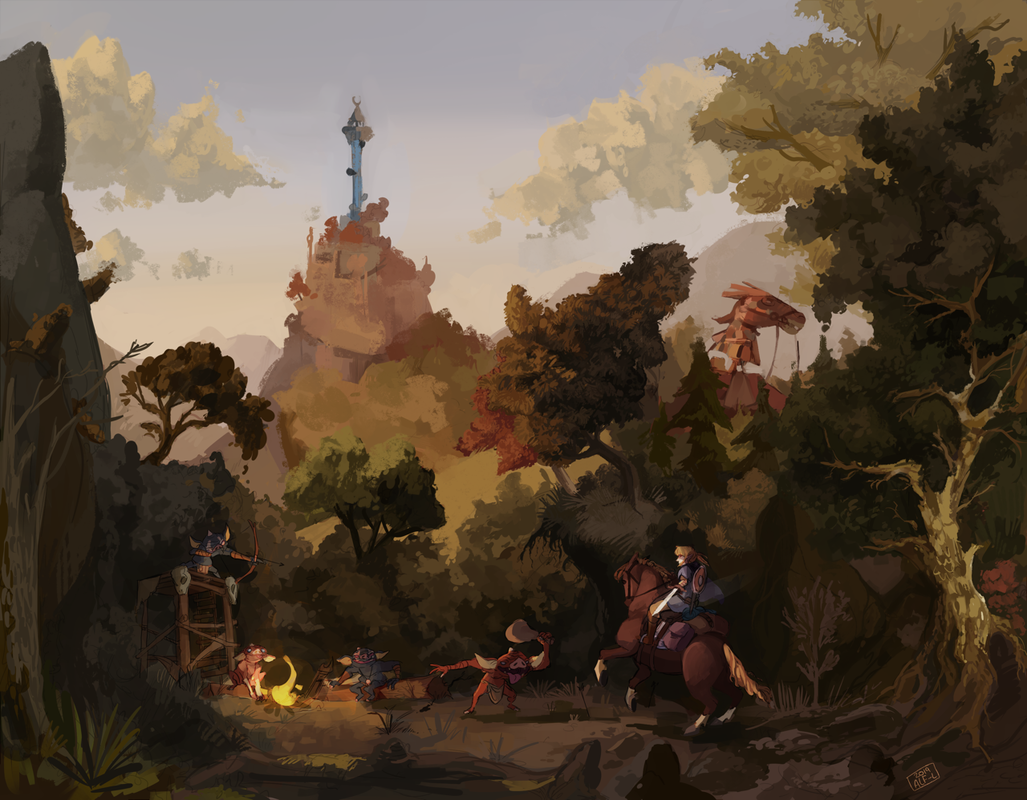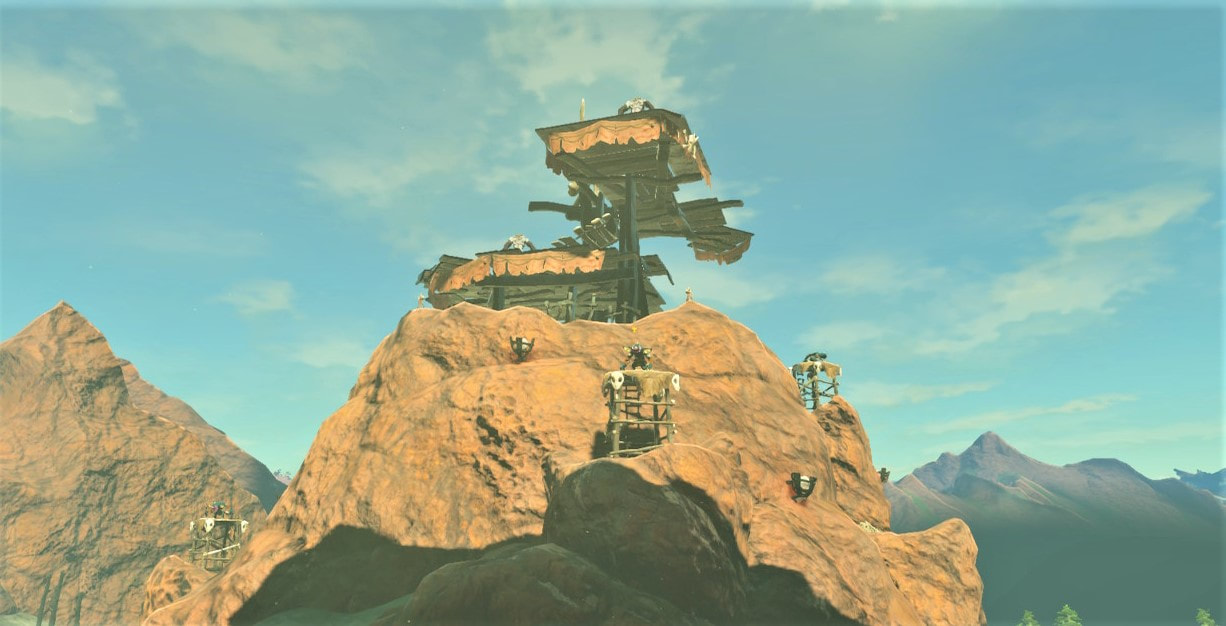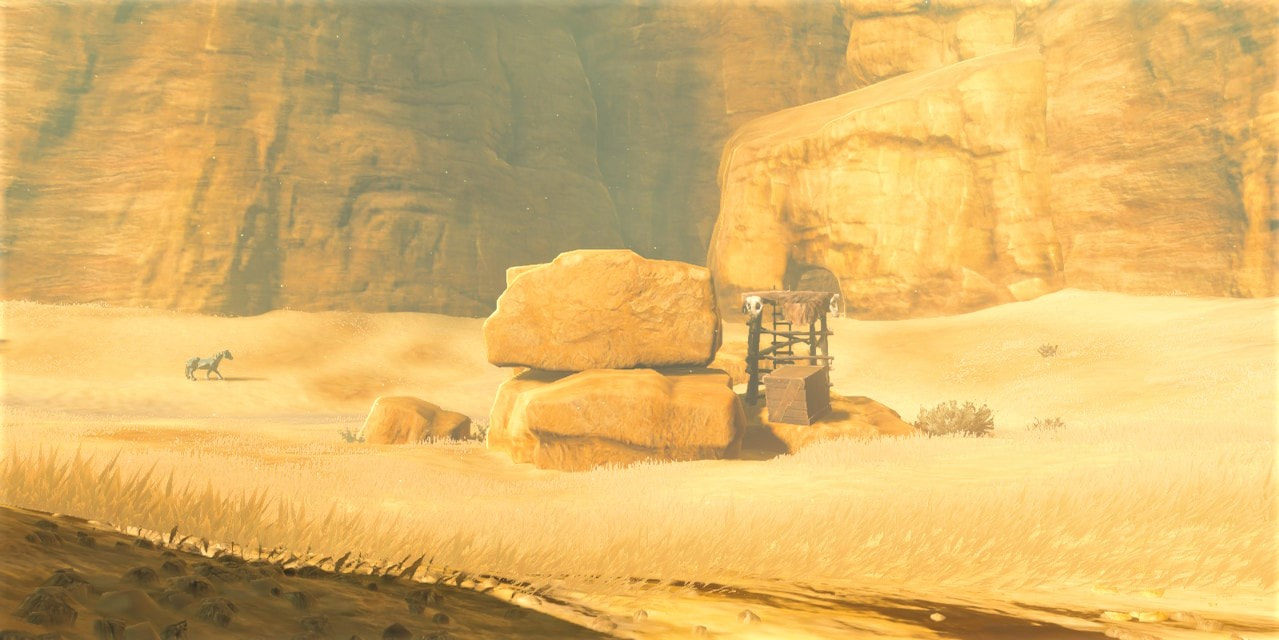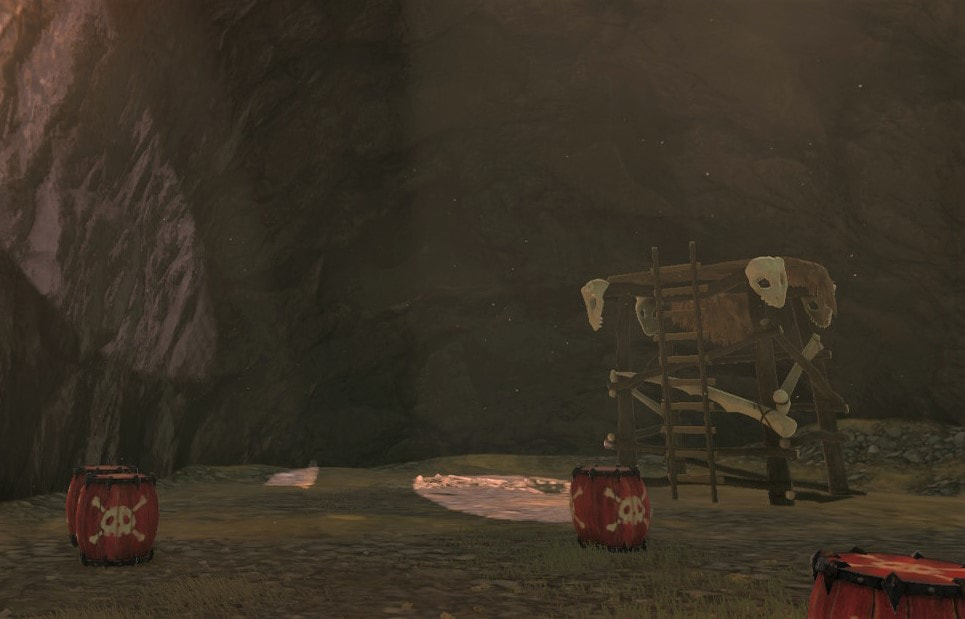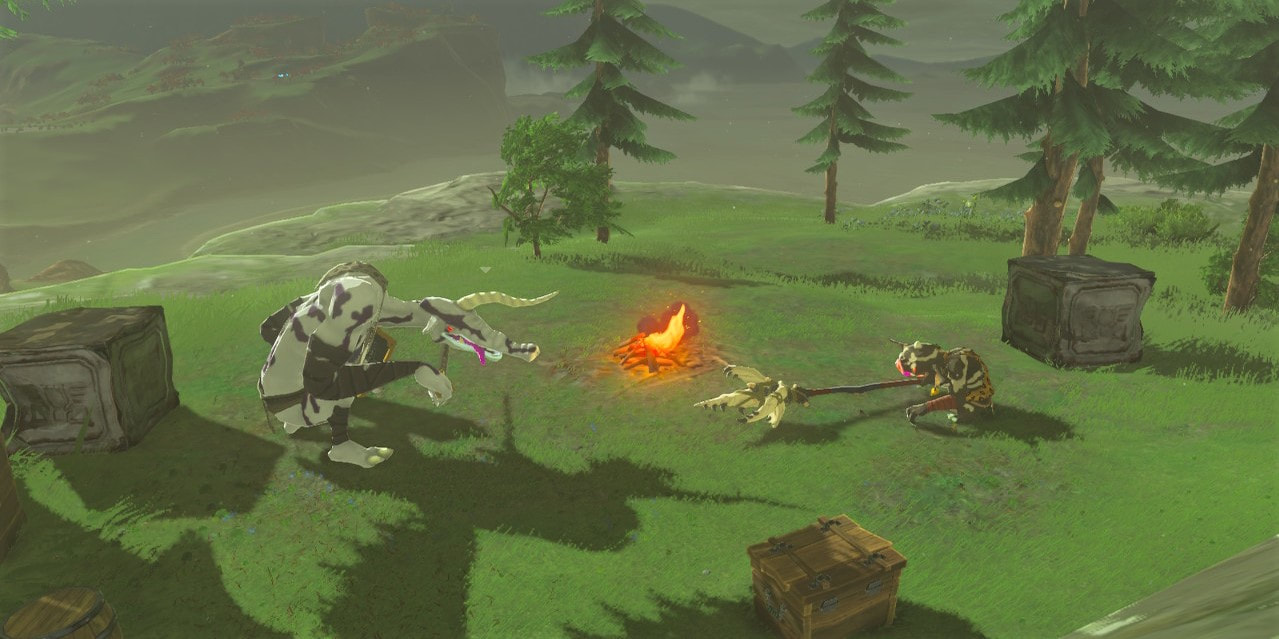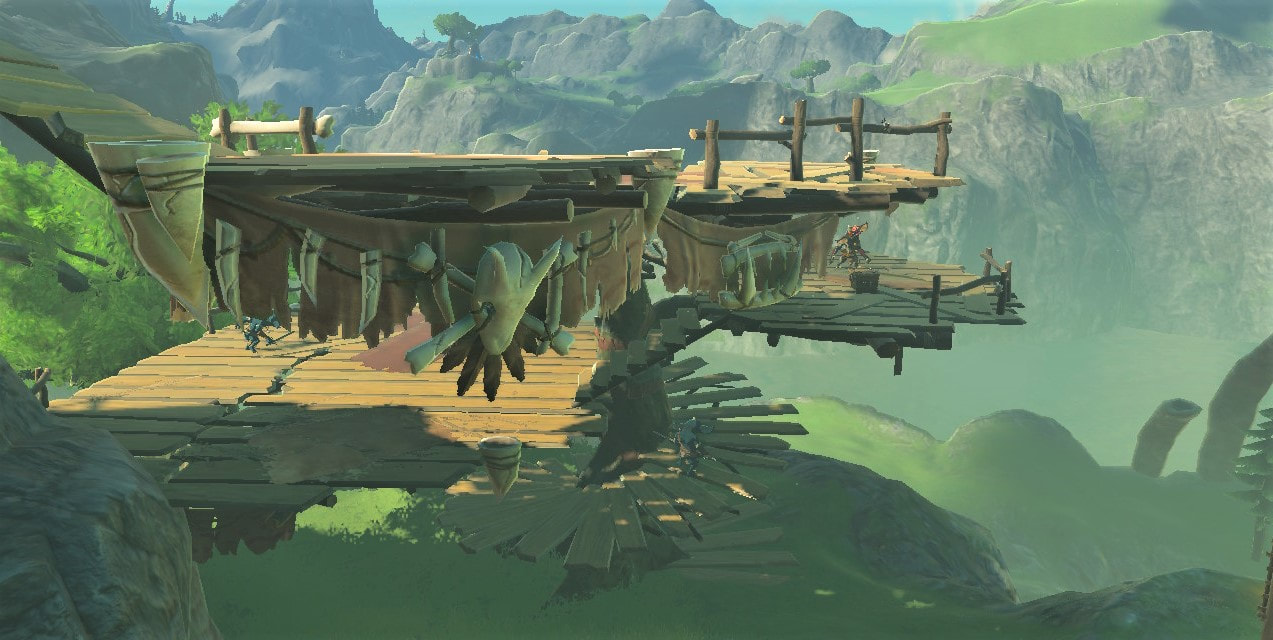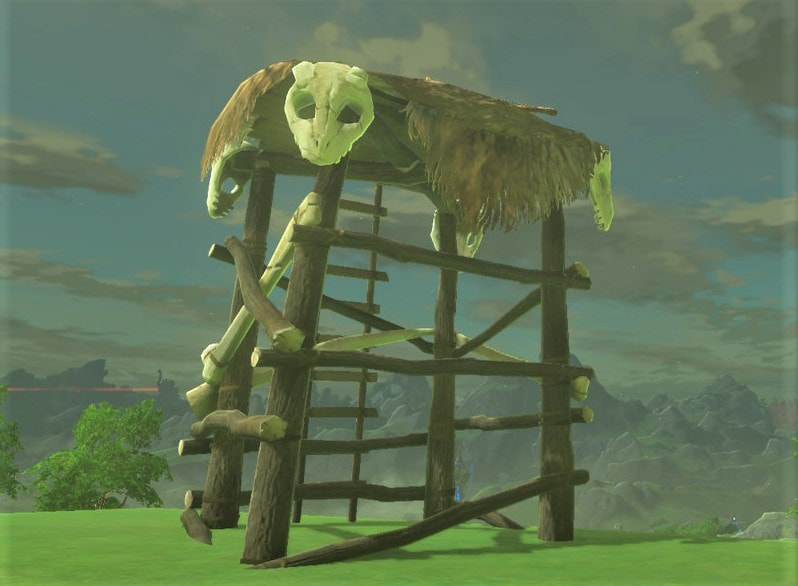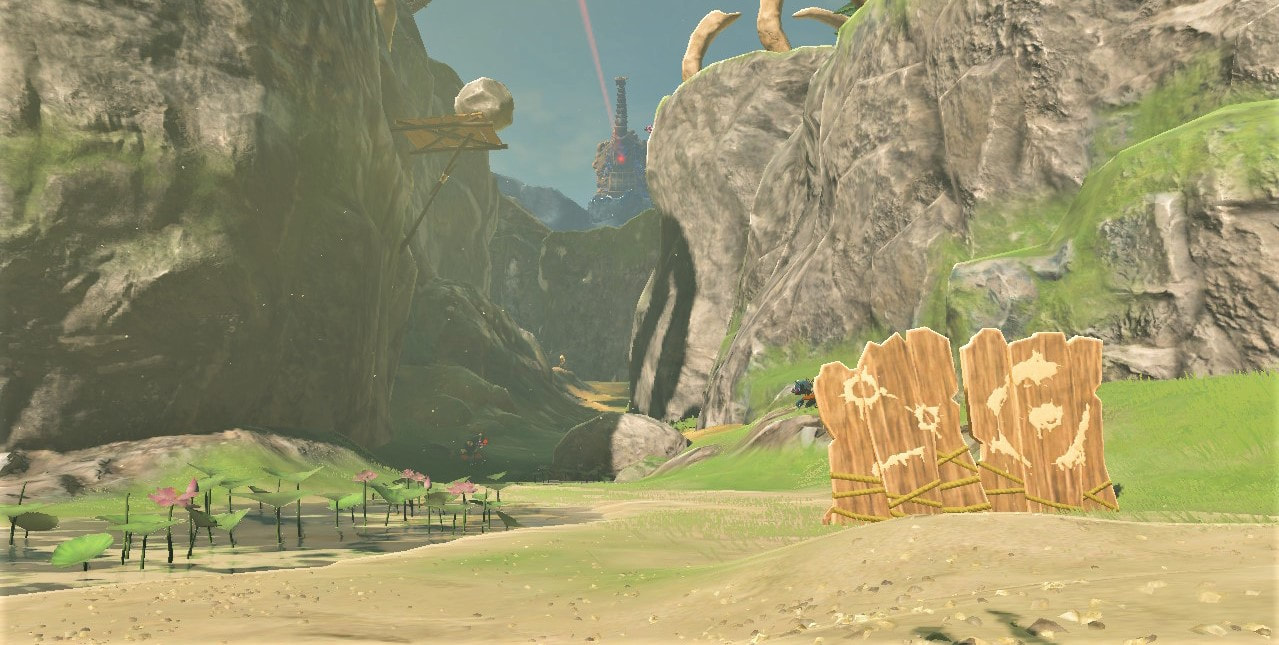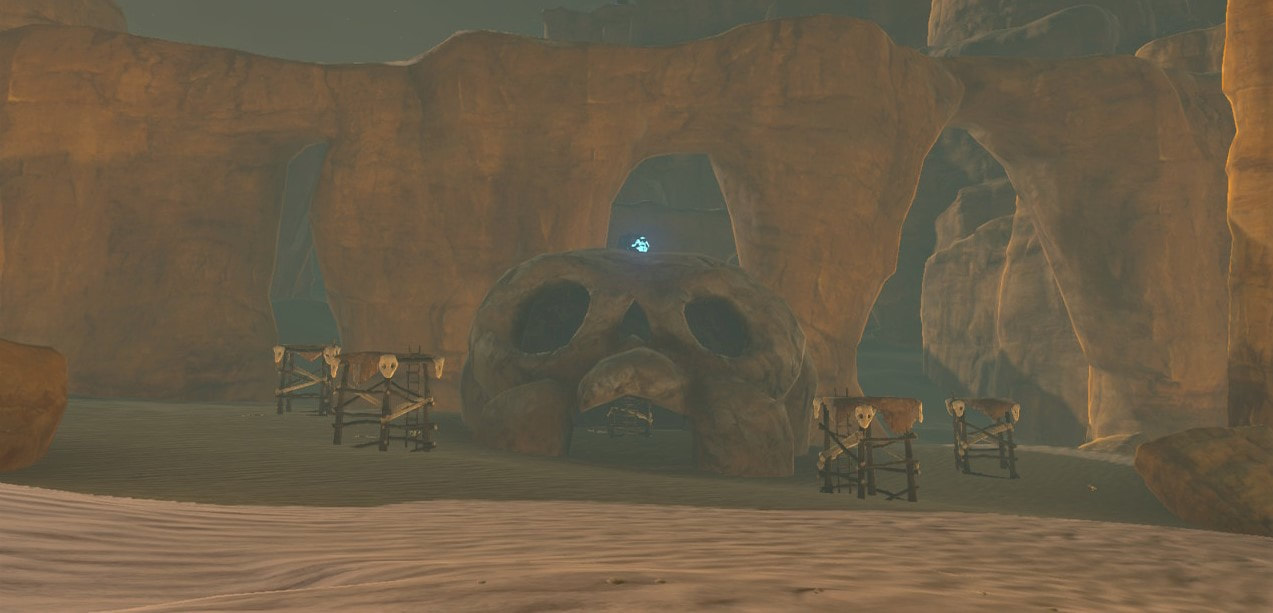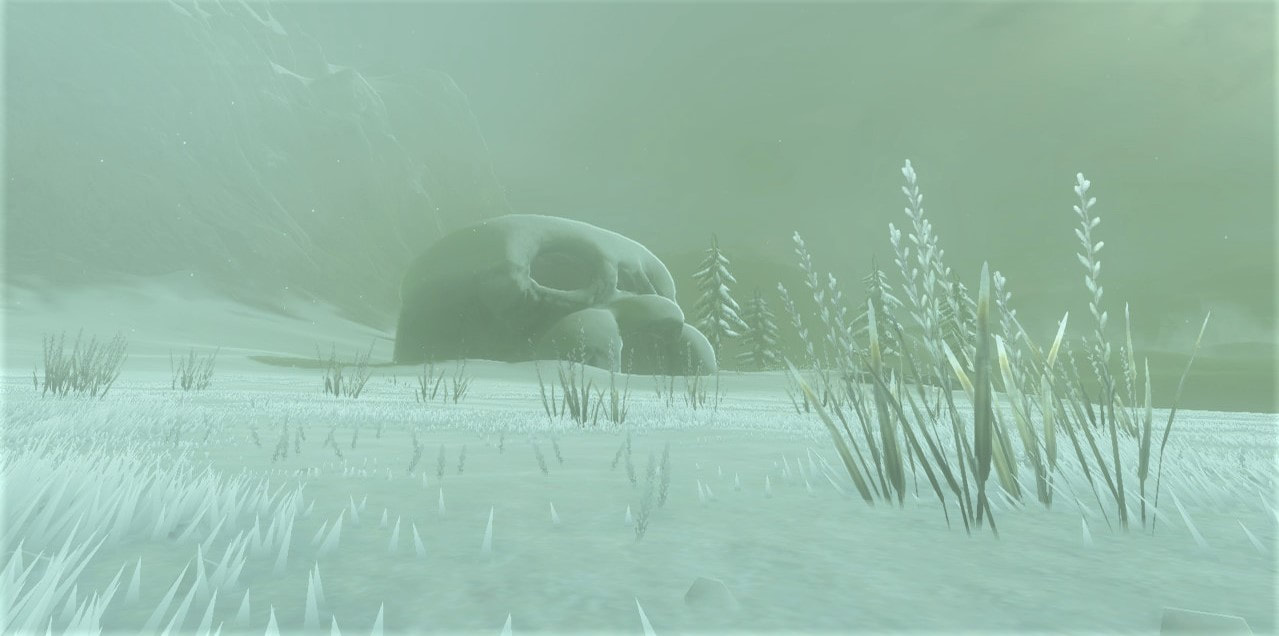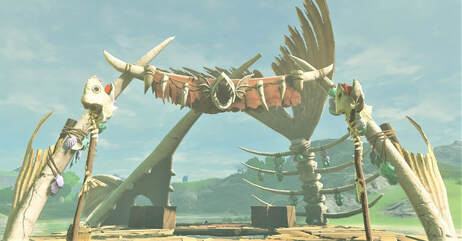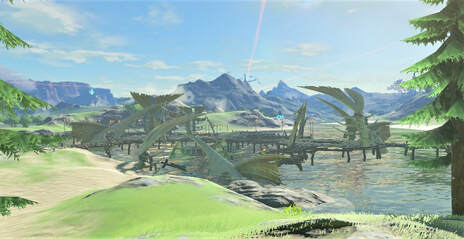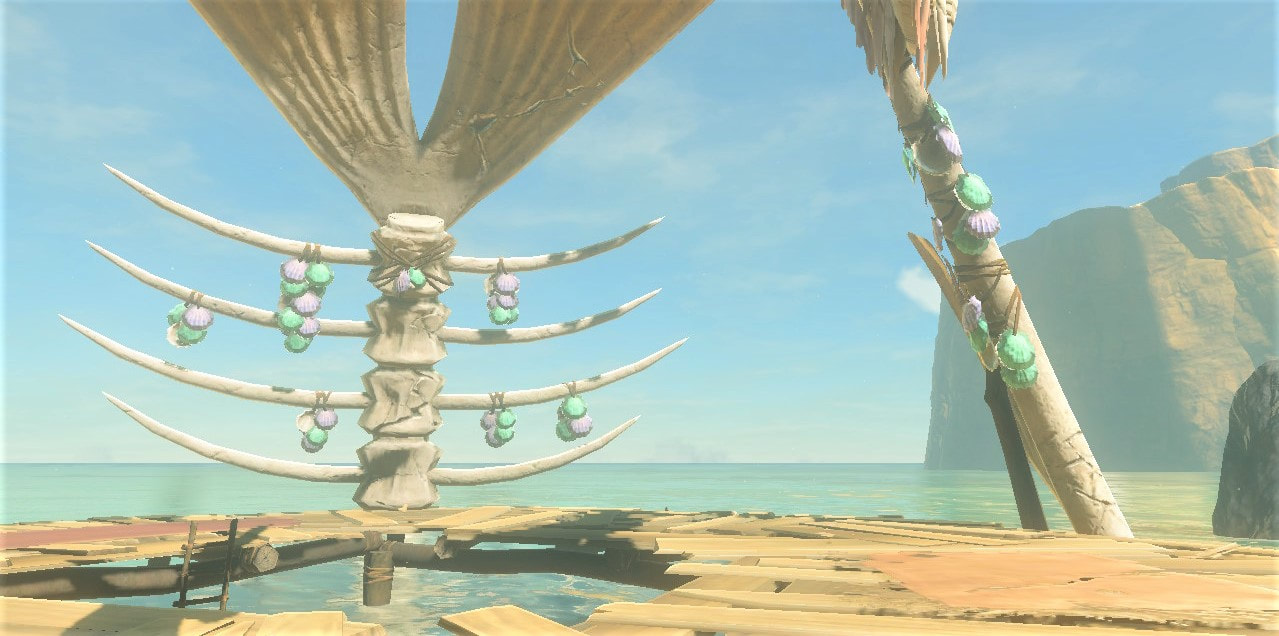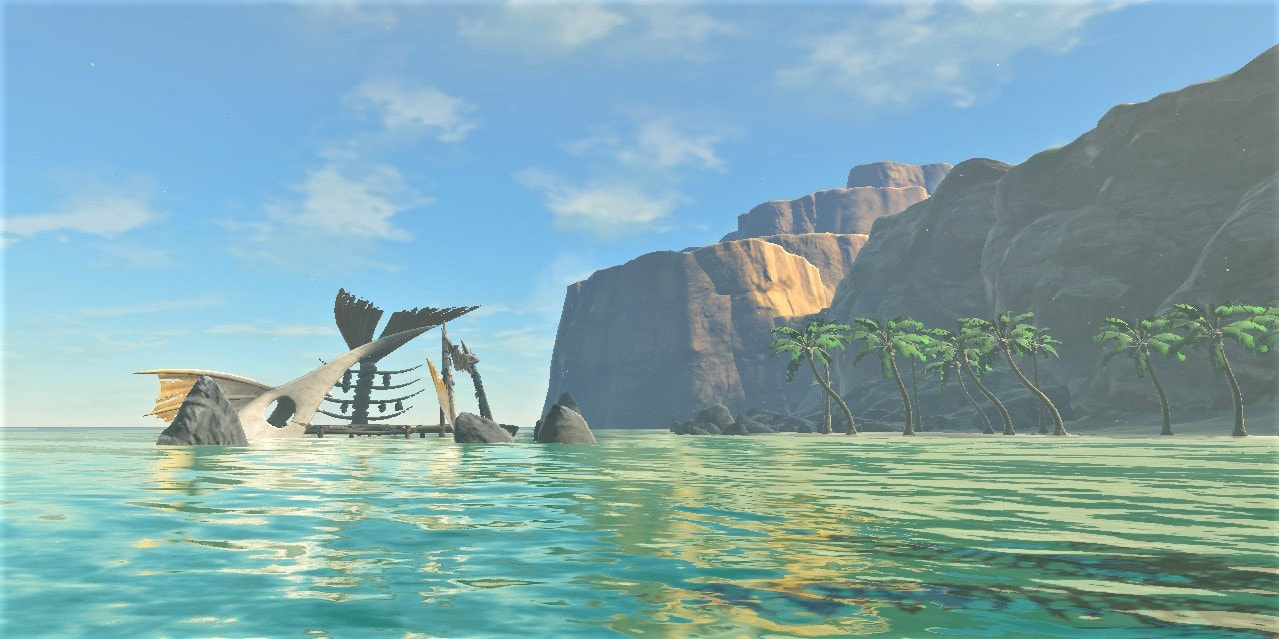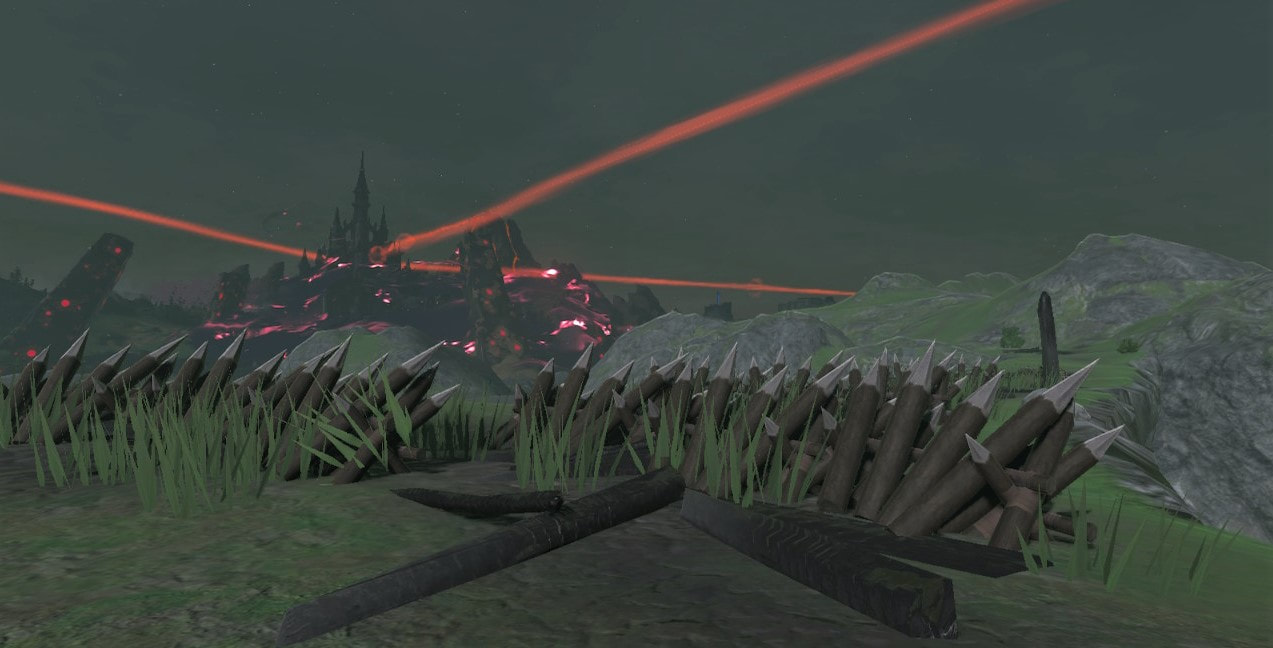Monster Strongholds
Written with help and advice from Hunter McGee and Matt Louscher
"I'm on patrol, keeping the watch! Monsters abound, so watch yourself!"
— Botrick, Breath of the Wild
"I'm on patrol, keeping the watch! Monsters abound, so watch yourself!"
— Botrick, Breath of the Wild
Monster Camp Near Akkala Citadel, by Anna Fischer. Used with permission of the artist (https://www.tumblr.com/alf-l).
Author’s Note: For clarity’s sake, I’ll define two terms up front: 1) Monsters — the sentient, organized species (e.g., Bokoblins) generally in service to Ganon who prove hostile to the major Hyrulean civilizations (I am not talking about Keese, etc.); and 2) Hyruleans/Civilizations/Free Peoples — the more advanced peoples of Hyrule, its predecessors, successors, and contemporaries, generally aligned with the Goddesses and other benevolent spirits (e.g., the Rito or Zora).
Introduction: Are Monsters Really so Monstrous?
Hyrule is a land of defenses. While there have been periods of peace, prolonged conflicts and skirmishes have whittled down the strength and vitality of all peoples, leading to a huge amount of concerted energy being poured into better means of protection. And this is true not just of the larger civilizations with their massive curtain walls, parapets, and Divine Beasts, but in the societies of the so-called monsters. Wherever one travels in Hyrule, one will encounter bulwarks, bastions, and barricades; like trees, streams, and the mountains, they seem simply a fact of existence. While the Sheikah keep to themselves in a naturally-fortified vale, the Gerudo strive for martial might, and the Zora build networks of bridges and moats, so too do the monsters of Hyrule look to their protection in various ways.
And not for nothing do the main civilizations of Hyrule protect themselves. While the free peoples were once vastly more numerous, the irruption of Calamity Ganon a century ago destroyed many settlements and killed untold numbers. The Hylians were hit particularly hard. But all Hyruleans suffered, and now all are greatly outnumbered by monsters throughout the land. A bit of digging reveals some fairly sobering figures: across Hyrule, there are over 200 enemy encampments, making it incredibly dangerous to go anywhere alone. These encampments vary greatly in size and sophistication. While the majority are simple camps centered around bonfires, there are 50 skull-cave encampments and another 50 forts built onto rocky hills, upon the water, or around the trunks of great trees. These strongholds shelter varying numbers of monsters, from small bands to larger battalions. But the sheer differences in population are the starkest fact of a harsh reality. Consider the following (very rough) figures: while the combined population of the great civilizations of Hyrule stands at around 375, the number of organized monsters pushes 2,350. [1] And these numbers do not include Hyrule’s other beasts and fiends.
And not for nothing do the main civilizations of Hyrule protect themselves. While the free peoples were once vastly more numerous, the irruption of Calamity Ganon a century ago destroyed many settlements and killed untold numbers. The Hylians were hit particularly hard. But all Hyruleans suffered, and now all are greatly outnumbered by monsters throughout the land. A bit of digging reveals some fairly sobering figures: across Hyrule, there are over 200 enemy encampments, making it incredibly dangerous to go anywhere alone. These encampments vary greatly in size and sophistication. While the majority are simple camps centered around bonfires, there are 50 skull-cave encampments and another 50 forts built onto rocky hills, upon the water, or around the trunks of great trees. These strongholds shelter varying numbers of monsters, from small bands to larger battalions. But the sheer differences in population are the starkest fact of a harsh reality. Consider the following (very rough) figures: while the combined population of the great civilizations of Hyrule stands at around 375, the number of organized monsters pushes 2,350. [1] And these numbers do not include Hyrule’s other beasts and fiends.
It is interesting to note that Hyruleans are not guiltless against the monsters that plague them. Like Kilton, the people of Hyrule have long sought monster parts to make goods and livelihoods. Claws, wings, talons, fangs, and tails are turned into elixirs, and things like Chuchu jelly can be turned into dyes for clothing. The rarer the monster, the higher the price. The monster trade in the Hyrulean economy has a long tradition, extending back in time as far as the Sky Era, when their parts were used to augment weapons and other technology. [2] And herein lies the conundrum: while monsters terrorize and threaten the peoples of Hyrule, still too are many livelihoods reliant on these dangerous elements. Of course, monsters were not always so organized, nor so powerful. During the era of the Ancient Sheikah, monster attacks were checked by the technological advancement of the Kingdom, and monsters ceased to pose a threat to Hyrule. [3] With the revival of Calamity Ganon, monsters grew fiercer and bolder, spreading throughout the land, hunting wild game to excess and putting additional pressures on the free peoples. Slightly before the events of 100 years ago, monsters became more active in harrying the citizens of Hyrule. Ganon’s malice began to seep out from its bonds, manifesting in fearsome Blood Moons that call to life previously-slain foes. So too did new breeds of monsters begin inhabiting the land; fearsome silver and gold beasts, mottled with unnatural colors — a symbol of Ganon’s influence — began to stalk the earth. [4]
This article deals solely with organized groups of monsters, as they seem to show signs of intelligence and culture apart from mere instinct; likewise, they have a somewhat developed material culture and basic elements of architecture in their grasp. While clearly more sophisticated than we might initially credit them, what we don’t know is the true extent of their monstrousness. Eiji Aonuma hinted in an interview that players might want to imagine what shaped monsters into what they currently are. [5] This just might relate to the Hyrulean hunt for their parts. If these organized monsters were not always threatening, we can imagine some distant event that caused mistrust, fear, and, ultimately, violence. Of course, this is speculative, and even were it the case, we could never know the initial catalyst — a Moblin unwittingly frightening a Hylian child or a Zora soldier slaying a Lizalfos out of a confused fear. Some series of events have led to the present moment, however, with great enmity between the sentient races of Hyrule.
These races of monsters, set apart from what we generally consider to be proper Hyruleans — the Zora, Gorons, Gerudo, Rito, Koroks, and Hylians — live predominantly in “loosely organized groups” centered around sanctuaries they have either built or discovered. [6] While some create bases of wooden scaffolding and barricades, others build large, multistory structures; yet others huddle for shelter in caves or build floating redoubts upon the waterways of Hyrule. And they can be found nearly everywhere uninhabited by the major civilizations, each encampment showing slight variations based upon environment. Although I will eventually separate the article into two sections based upon the individual type of monster, please keep in mind that these three species more often than not work in cahoots; they live together, fight together, and communicate with one another in various ways. As with all things, reality is more complex than any words can describe. Before talking about monsters by species, let us take a brief historical interlude.
This article deals solely with organized groups of monsters, as they seem to show signs of intelligence and culture apart from mere instinct; likewise, they have a somewhat developed material culture and basic elements of architecture in their grasp. While clearly more sophisticated than we might initially credit them, what we don’t know is the true extent of their monstrousness. Eiji Aonuma hinted in an interview that players might want to imagine what shaped monsters into what they currently are. [5] This just might relate to the Hyrulean hunt for their parts. If these organized monsters were not always threatening, we can imagine some distant event that caused mistrust, fear, and, ultimately, violence. Of course, this is speculative, and even were it the case, we could never know the initial catalyst — a Moblin unwittingly frightening a Hylian child or a Zora soldier slaying a Lizalfos out of a confused fear. Some series of events have led to the present moment, however, with great enmity between the sentient races of Hyrule.
These races of monsters, set apart from what we generally consider to be proper Hyruleans — the Zora, Gorons, Gerudo, Rito, Koroks, and Hylians — live predominantly in “loosely organized groups” centered around sanctuaries they have either built or discovered. [6] While some create bases of wooden scaffolding and barricades, others build large, multistory structures; yet others huddle for shelter in caves or build floating redoubts upon the waterways of Hyrule. And they can be found nearly everywhere uninhabited by the major civilizations, each encampment showing slight variations based upon environment. Although I will eventually separate the article into two sections based upon the individual type of monster, please keep in mind that these three species more often than not work in cahoots; they live together, fight together, and communicate with one another in various ways. As with all things, reality is more complex than any words can describe. Before talking about monsters by species, let us take a brief historical interlude.
Hunting Monsters Through Time
If we had to adopt a basic premise to describe monster culture over the eras, it would be this: Monsters seem to rise to the ambient level of technology present in any age. This is to say that they match the technological progress of more advanced societies, but only in certain aspects. Monsters themselves generally do not show a great capacity for technological innovation, but they are often incredible mimics and skilled learners. In times as distant as the Sky Era, we have seen monsters, especially Bokoblins, steal and adopt the technologies of their neighbors. In Skyward Sword’s Lanayru Province, we have our earliest evidence for this claim in the Technoblins pilfering both electricity and weaponry from the Ancient Robots. Fi tells us that this technology was created by an ancient and highly-evolved culture, so while it was not made by Bokoblins, it was eventually mastered by them. [7] The Technoblins also use cages to sap electricity from their enemies, and they seem to understand the inner workings of the Sandship, a vessel constructed in the Lanayru Shipyard likely by the Ancient Robots. These monsters are no slouches, and have even discovered how to activate the ship’s cloaking mechanism. Later in the Sky Era, after the phasing out of the Ancient Robots and the lifting of Skyloft into the heavens, it might be supposed that monsters had lost all their technological progress as they had no one from which to steal. Yet, Bokoblins during this later period still have helmets, bows, and various other adornments, meaning that they can to some extent replicate existing technologies, though they don’t seem capable of improving upon them.
In The Wind Waker, monsters are even more organized, especially those in service to Ganondorf in the Forbidden Fortress. There we see evidence of woodworking capabilities on par with those of the Hylians of the time — rafts, platforms, and even wooden submersibles. The monsters here have learned how to use explosives and gunpowder in their cannons, operate searchlights, use telescopes and periscopes, and domesticate Kargarocs. As the base was once a lair of pirates, it is likely that monsters moved in later, mastering the technology as they took control of the stronghold.
Yet everything has devolved by the era of Breath of the Wild. Mirroring the Hylians of this era, monsters have lost almost all earlier knowledge and technologies. If our basic premise is correct, and monsters seem to rise to the ambient level of technology in their environment, this makes a great deal of sense. This regression can also be seen in their social networks and structure. They no longer have set patrols, daily tasks and schedules, structured military organization, or a robust division of labor. Why should this be? There are many potential reasons, but two stand out: 1) As was mentioned above, as Hylians lost technological ground, so too did monster culture match this atavism; 2) Monsters need leadership, and they have no present leader. In Skyward Sword, Ghirahim commanded monsters; in The Wind Waker, Ganondorf led monsters toward greater ends than they could conceive on their own. With Ganon sealed by Zelda in Hyrule Castle, monsters are now left to their own devices, scrounging a living off the land without a higher aim in life. This is not, of course, to say that monsters are helpless and pathetic without a dictator above them; rather, they are not as formidable without one. [8] They are less diabolical when ungoverned, and more wild. And this is a key difference. Let us now turn to the three major species of monsters.
In The Wind Waker, monsters are even more organized, especially those in service to Ganondorf in the Forbidden Fortress. There we see evidence of woodworking capabilities on par with those of the Hylians of the time — rafts, platforms, and even wooden submersibles. The monsters here have learned how to use explosives and gunpowder in their cannons, operate searchlights, use telescopes and periscopes, and domesticate Kargarocs. As the base was once a lair of pirates, it is likely that monsters moved in later, mastering the technology as they took control of the stronghold.
Yet everything has devolved by the era of Breath of the Wild. Mirroring the Hylians of this era, monsters have lost almost all earlier knowledge and technologies. If our basic premise is correct, and monsters seem to rise to the ambient level of technology in their environment, this makes a great deal of sense. This regression can also be seen in their social networks and structure. They no longer have set patrols, daily tasks and schedules, structured military organization, or a robust division of labor. Why should this be? There are many potential reasons, but two stand out: 1) As was mentioned above, as Hylians lost technological ground, so too did monster culture match this atavism; 2) Monsters need leadership, and they have no present leader. In Skyward Sword, Ghirahim commanded monsters; in The Wind Waker, Ganondorf led monsters toward greater ends than they could conceive on their own. With Ganon sealed by Zelda in Hyrule Castle, monsters are now left to their own devices, scrounging a living off the land without a higher aim in life. This is not, of course, to say that monsters are helpless and pathetic without a dictator above them; rather, they are not as formidable without one. [8] They are less diabolical when ungoverned, and more wild. And this is a key difference. Let us now turn to the three major species of monsters.
Blins (Bokoblins & Moblins)
Bokoblins are the most numerous type of monster, living, hunting, and attacking in groups. Like all Blins, they are actually demonic creatures which “tend to be a violent, simple sort who are quickly aggressive with just about any living thing they encounter.” [9] Servants of more powerful Demon Lords, these footsoldiers are summoned into battle, and thus are not endemic to Hyrule — they are interlopers apart from nature. [10] Unnatural as they are, however, they have gained some mastery over the environment. They are able to stalk prey and use fire, and have even learned to tame horses and attack from horseback. They have a defined culture with the bonfire at its center, around which many cultural activities take place. Here Bokoblins can be seen chatting, laughing, eating, sleeping, picking their noses, and even dancing. [11][12] They are an intensely social species, as has been documented elsewhere. [13] Like all Blin groups, things are organized hierarchically with the strongest Blin at the top. [14] Like Bokoblins, Moblins can be found nearly everywhere in Hyrule, though they have a less rich material culture. While they adorn their bodies with patches of armor, we do not know the extent to which they build when apart from their Bokoblin or Lizalfos allies. Being tall, they have no need for watchtowers. But even though they do not build settlements alone, once they have settled a territory, they guard it from head to toe, always on patrol against intruders. Moblins enjoy stalking about larger ruins like the East Post Ruins or the old Military Training Camp — places with large walls and spacious hallways. They are often seen in bands with Bokoblins, and they occasionally use them as makeshift ranged weapons. Small betrayals aside, we can see how intimately related all Blins are; they even seem to joke with one another. But though they have evolved from simple attack-and-defend behaviors and are no longer purely martial, they are nearly always on the watch — waiting either to accost travelers or simply protect themselves from being caught unawares.
But this is not to say that Blins have mastered defensive tactics: in some instances, they dwell unprotected beneath cliffs where they can be easily attacked from above, hole up in caves with no means of retreat, and occasionally build towers lower than the barricades they erect, making them unable to peer outside their own defenses. [15] Their encampments are numerous, ranging from inhabited tree stumps and skeletal remains to repurposed ruins. The most basic of these are mere campsites centered around cooking pots or bonfires, completely exposed to the elements. There are tens of these littered across Hyrule, though we ultimately don’t know whether Blins moved the cooking pots to their present locations or if they simply made camp around those they discovered. And at many camps can be found various plundered goods from around Hyrule: boxes, barrels, various viands, powderkegs, arrows, rupees, chests, ladles, mops, and low-quality weapons. Occasionally, one stumbles across a well-guarded chest, intimating that Blins perhaps have some concept of comparative value. These treasures range from rupees to fine gemstones to rare weapons. So, monster camps serve many functions: They are social centers, safe havens, and also places where valuables are tucked away for future use.
But this is not to say that Blins have mastered defensive tactics: in some instances, they dwell unprotected beneath cliffs where they can be easily attacked from above, hole up in caves with no means of retreat, and occasionally build towers lower than the barricades they erect, making them unable to peer outside their own defenses. [15] Their encampments are numerous, ranging from inhabited tree stumps and skeletal remains to repurposed ruins. The most basic of these are mere campsites centered around cooking pots or bonfires, completely exposed to the elements. There are tens of these littered across Hyrule, though we ultimately don’t know whether Blins moved the cooking pots to their present locations or if they simply made camp around those they discovered. And at many camps can be found various plundered goods from around Hyrule: boxes, barrels, various viands, powderkegs, arrows, rupees, chests, ladles, mops, and low-quality weapons. Occasionally, one stumbles across a well-guarded chest, intimating that Blins perhaps have some concept of comparative value. These treasures range from rupees to fine gemstones to rare weapons. So, monster camps serve many functions: They are social centers, safe havens, and also places where valuables are tucked away for future use.
Concerning built environs, we should note that the rough vernacular of monster architecture is remarkably similar all across Hyrule. There seems to be a fixed set of archetypal buildings found from the Gerudo Desert to the woods of Akkala, though materials vary based on region; wood is favored in most places, but metal is used as a primary material on Death Mountain due to its heat. This set of common structures consists primarily of skull-caves, sentry turrets, single-story tree forts, water redoubts, and multistory fortresses. Oftentimes, one finds these buildings combined into larger settlements, with multiple sentry turrets protecting a single cave, for instance. Other tell-tale signs of monster presence in an area include wooden barricades, spiked logs (a sort of fraise defense), mantlets, and torches housed in skulls. In all monster architecture, we quickly come to realize that no structure is ever wholly built by monsters; the presence of nails and milled lumber gives some idea of their provenance among the Hyrulean civilizations. [16] Yet this is not to say that the monsters of Hyrule are completely without craftsmanship (craftsmonstership?). Even their smallest turrets are built of posts and beams, which are rounded off so as to form joints, adding greatly to stability. The posts are given further support by wood-and-bone cross bracing, by no means a construction technique that should be overlooked, as it massively improves structural integrity. This bracing is held to the posts by rope, as are other horizontal log braces. These braces serve separate, though complementary, functions in distributing load and preserving the structure. Again, no small feat.
Another common structure is the tree-fort: usually an elevated platform with a single raised section. These are commonly inaccessible from the ground, but for the occasional drawbridge. Here, the platform is supported by four to five rough-hewn posts, and the scavenged boards of the floor are undergirded by rather haphazard limb supports. Some of these supports are jointed while others are merely fastened together with rope. Perhaps unsurprisingly, the tree’s native branches are also used as supports. There are many cracks in the woodwork, so to say, but these platforms serve the desired function of raising their inhabitants off the ground. One of the larger fortresses of the same style has at least three stories and is connected by further bridges to the mountain at its back — a well-chosen site closely tied to its structure. Here we see similar construction methods, but a clear difference is the winding stair that circles the tree (now dead) on which this fortress is built. Long, clumsy planks and curiously-flat bones are used as the individual steps, all held up by rough limbs, square frames, and lengths of rope. Here too is seen something uncommon to much monster architecture: railings. These are constructed in much the same way — of wood and bone — and are just high enough to keep a Bokoblin from taking a tumble. (One does wonder about Moblin safety, though.) Piles of grass and straw serve for sleeping, as do filched rugs, now long faded. Most curious of all are the adornments these creatures use as decoration. Bones, skulls, and fangs are commonplace, and even the merest turret has a monster skull affixed to each corner with rope. Interestingly, this skull motif has always been prevalent in Bokoblin culture, even from our earliest knowledge of it; this is evidence of an impressive continuity in their material culture. In Skyward Sword, Bokoblins carry around ornamental and golden skulls, which can be seen as emblematic of their culture. [17] In larger structures, the skulls and fangs grow to match, placed upon all available corners and sawn-off tree limbs. Ribbons are hung dangling from tree branches above, while the central trunk is often wrapped in faded red and blue strips of cloth. Banners hang from the platform on loose rope, highlighting the garish skull-and-crossbones and monster-maw motifs placed at their centers. Monsters seem to have some facility with dyeing or painting, as well, as rough designs can be found upon many banners and mantlets near monster camps.
We don’t know if the large, skull-shaped rocks were naturally formed or if they were built by some species in Hyrule. Given the remarkable conformity of these rocks, it could be that they were constructed, though by whom presents a daunting question. It is unlikely that they were shaped by monsters, who seem not to have the tools or skills necessary to hollow out such boulders. Yet, if not the monsters, then who or what would carve such a thing and in such numbers? Another answer is that they are naturally occurring, like a stalagmite, hoodoo, natural arch, or butte — a unique form which occurs as a result of water, wind, and weather. Whatever their origins, they provide excellent shelter, though they are not defensively sound. The thing that is most obvious is that they are favored hideouts of monsters. With gaping jaws as entrances, and three holes above where eyes and nose would be, the caves appear as giants emerging from deep below ground, swallowing up mouthfuls of earth. Inside is dim, though usually lit by lamps hung from the ceiling and the occasional fire. Here one finds much of the same camp gear as in other monster settlements and the occasional guard turret and treasure chest. The caves are haunting, in a way, and watching the light leak through empty eye sockets onto the floor presents an interesting meditation.
Lizalfos
Lizalfos are the most intelligent of the organized monsters and are a common sight in all parts of Hyrule. They are also the most differentiated based upon environment, making one suspect that they are either older than the other organized monsters or simply dispersed to different climates long before the other species. It is also possible that their chameleonic identity allows individuals to adapt to whichever climate they inhabit. Some are suited to the mountain heights while others are at home in the desert. There is an elemental affinity unique to the Lizalfos, such that the Fire-Breath variety can breathe fire or swim in lava and the Ice-Breath subspecies can shoot ice and survive the coldest areas of Hyrule. Lizalfos that don’t live in bands use camouflage to hide. Those Lizalfos that show the most organization construct platforms on the water to protect themselves with a natural moat quite removed from the land. As these bases float upon a flat expanse, any approach is immediately visible to guards, preventing sneak attacks. This, combined with the fact that Lizalfos do not sleep, makes any approach to such an encampment a difficult project. [18]
Though Lizalfos are developed metalworkers (an element of Lizalfos culture since the Sky Era where these monsters wielded iron arm-guards and spiked balls upon their tails), their woodworking skills pale in comparison to those of the Blins. Their platforms are held together only by ropes, and planks of wood are simply placed atop one another to form a floor, occasionally overlaid with straw or the odd rug. There is no use of nails, no binding, no roping, and no joinery to speak of. The boards of the bridges leading to these platforms are sometimes lashed together with rope, though they are not bound to the platforms themselves. The floor shape of these structures resembles the square-in-circle design of an ancient Chinese coin. The hole in the middle of the floor is still part of the vernacular architecture, and is where the tree would be in a Bokoblin tree-fort. Here there are often ladders, allowing creatures to get in and out of the water safely, all while keeping the entrance inside the redoubt. (It also reminds one slightly of the aperture of an open-bottomed diving bell.)
Most notable on these platforms are the enormous sea-creature skeletons: fossilized fins as well as spines and skulls. They give some protection from the sun and elements and also hold up the main decorative materials: strung-together shells, which serve almost as a sort of wind-chime, and the cloth banners overlaid with bones as seen elsewhere in monster architecture. The ropework here was likely done in cooperation with Blins, as the Lizalfos show no evidence of this skill elsewhere in their architecture. The large bones are well-integrated with the platforms, such that they appear a natural part of their surrounds. From afar, these floating camps give the impression of massive sea-monsters breaching in the distance — a straightforward sign of danger.
Most notable on these platforms are the enormous sea-creature skeletons: fossilized fins as well as spines and skulls. They give some protection from the sun and elements and also hold up the main decorative materials: strung-together shells, which serve almost as a sort of wind-chime, and the cloth banners overlaid with bones as seen elsewhere in monster architecture. The ropework here was likely done in cooperation with Blins, as the Lizalfos show no evidence of this skill elsewhere in their architecture. The large bones are well-integrated with the platforms, such that they appear a natural part of their surrounds. From afar, these floating camps give the impression of massive sea-monsters breaching in the distance — a straightforward sign of danger.
Conclusions: The Monster Within
I speculated a bit at the beginning as to the origins of monster antipathy toward Hyruleans. Things are not so clear as that, however. There are certain exceptions to this rule, and many instances where the line between monster and free peoples becomes murky. Take, for instance, the case of the Lorulean Children and the Octorok jointly running a minigame in A Link Between Worlds or the unclear relationship between Maggie and Moe in The Wind Waker. And remember that Deku Scrubs vary wildly in temperament; in The Minish Cap, the Scrub attacking Princess Zelda reveals that he doesn’t mean to attack her — it’s just that Scrubs inadvertently fire out seeds when talking. Some people who enter the Dark World become monsters in A Link to the Past. King Bulblin commits treason and alters his allegiance when finally defeated by Link in Twilight Princess. One extremely powerful example of this unclear line is in the protean nature of the Zora; in the fallen branch of the timeline, the Zora eventually morph into a race of monsters. In Oracle of Ages, there are two subspecies of Zora: the friendly sea-dwelling Zora and the loathsome Zora of the river. The Masked Followers of A Link Between Worlds really muddy the waters. As Lorule disintegrates after the destruction of its Triforce, monsters grow in influence and freedom. People see this and begin to worship monsters, turning their backs on organized Lorulean culture, government, and even religion. Guards who once protected the royal family turn cloak. Members of the Masked Cult wear monster masks as disguises, some even hoping to become monsters. And while it is possible in certain instances to become a monster, so too is it possible to lose one’s monstrousness, as in the case of Skyward Sword’s Batreaux. [19]
Given all these oddities, it might not be that monsters are genetically determined to hate Hyruleans, though they seem to have that general predilection. Why might this be? Again, it could stem from one defining moment in monster-Hyrulean relations, but it is likely something much deeper than that. As we learn in Skyward Sword, Demise is the origin of all monsters. Yet his origin is unclear. We do not know if he first existed outside the spheres of the world, much like the Golden Goddesses, or if he is himself a part of their creation. Yet, we know that he has transcended death and time and attained nearly godlike power. In earliest history, he ascended from the Underworld at the head of an army to wage war upon the surface. But why? If he exists alongside the Goddesses in some capacity, it is odd he should be so focused upon the domination of one land. Things become infinitely more interesting if he turns out to be a creation of the Goddesses — some aspect of the Divine Order.
So why the hatred and tyranny? As Ganondorf so poignantly tells us in The Wind Waker, “I coveted that wind, I suppose . . . .” In the Order of things, Demise has been assigned the role of destroyer and usurper — an entity of malice and hatred. It isn’t obvious that Demise approves of his allotted place in the Divine Plan. Rather, he seems to rebel against it, and the reasons are manifold. It seems rather obvious that those he rules over live in unfortunate conditions when contrasted against those peoples blessed by the Goddesses. Therefore, he refuses to accept the order of things and rebels against those who have been blessed for no obvious reason. The imbalance is remarkable, and the injustice intolerable. Why should the Zora and Hylians live in greater material and spiritual comfort than Demise and his followers? Is a random Hylian responsible for his blessed fate in any way? Did a monster do something to deserve its lot? The answer is likely inscrutable, as with the problems of badness, suffering, and misery in all religions, but this inscrutability does not make the facts more palatable. Seen in this light, Demise’s struggles — and the struggles of his countless incarnations — make sense. Indeed, they are the only thing that makes sense. It is then justifiable that monsters would therefore hold a vague, inborn grudge against all the free peoples of Hyrule, even if some few can break free of this hatred. Like their god and master, they too have been cheated. They too have been cursed. And so they seek to take their share of the world’s plenty. They seek to take a place in the light. History, through this lens, is one of unfortunate and persecuted peoples justly defying an unjust Divine Order.
But should the free peoples, recognizing this injustice, simply call it a day? Should they retreat from Hyrule and give up their land, resources, and homes? It depends. What are the aims of the Demon Lords and their soldiers? Are the monsters seeking a place in the light alongside Hyruleans, or in place of them? Even if all the civilizations of Hyrule agreed that the fate of the monsters was an unjust one, it is psychologically unspeakable to think about dying so as to simply free up space for others. It could never happen. Thus, there is conflict. Without the demons giving up their dreams of total conquest or the Hyruleans simply giving up, there will always be conflict. [20] Even so, neither side is obviously or totally wrong. In a sense, it is an existential game both sides are playing. This, then, is the chief riddle of the monster: Who or what ultimately made them what they are — nature, Demise, or the Goddesses themselves?
Let us return now from such heady things to monsters as we know them. Though not as advanced as any of the major civilizations of Hyrule, monsters still give us quite a lot to think about. They remind us almost of early humans, just learning their place in the world and how to find their feet. They have begun to use fire in cooking, wood and bone in tools and weaponry, and horns for communication. They have tamed horses and invented dance. These are no small milestones in evolution, and perhaps this should inspire fondness in us — after all, it was only a bit ago we too were making such breakthroughs. Indeed, the small bands scattered across Hyrule can even be seen with some degree of pathos, arrayed as they are against beings whose technology they cannot understand. What is a simple bone spear up against an Ancient Arrow or Guardian? Are the Divine Beasts enemy gods? To a small pack of monsters, the world must seem a rather terrifying place. And what made them monsters in the first place? Do they serve Ganon willingly or out of fear? Would they remain antagonistic were they not hunted for parts? As anytime we are confronted by our own violence, we begin to unravel a bit, asking questions we fear to have answered. We begin to see that we have been looking through a glass, darkly. On the face of it, monsters are straightforward enemies, protecting items and information we need in order to save the world. But save the world for whom? In the end, just who is the real monster here?
Given all these oddities, it might not be that monsters are genetically determined to hate Hyruleans, though they seem to have that general predilection. Why might this be? Again, it could stem from one defining moment in monster-Hyrulean relations, but it is likely something much deeper than that. As we learn in Skyward Sword, Demise is the origin of all monsters. Yet his origin is unclear. We do not know if he first existed outside the spheres of the world, much like the Golden Goddesses, or if he is himself a part of their creation. Yet, we know that he has transcended death and time and attained nearly godlike power. In earliest history, he ascended from the Underworld at the head of an army to wage war upon the surface. But why? If he exists alongside the Goddesses in some capacity, it is odd he should be so focused upon the domination of one land. Things become infinitely more interesting if he turns out to be a creation of the Goddesses — some aspect of the Divine Order.
So why the hatred and tyranny? As Ganondorf so poignantly tells us in The Wind Waker, “I coveted that wind, I suppose . . . .” In the Order of things, Demise has been assigned the role of destroyer and usurper — an entity of malice and hatred. It isn’t obvious that Demise approves of his allotted place in the Divine Plan. Rather, he seems to rebel against it, and the reasons are manifold. It seems rather obvious that those he rules over live in unfortunate conditions when contrasted against those peoples blessed by the Goddesses. Therefore, he refuses to accept the order of things and rebels against those who have been blessed for no obvious reason. The imbalance is remarkable, and the injustice intolerable. Why should the Zora and Hylians live in greater material and spiritual comfort than Demise and his followers? Is a random Hylian responsible for his blessed fate in any way? Did a monster do something to deserve its lot? The answer is likely inscrutable, as with the problems of badness, suffering, and misery in all religions, but this inscrutability does not make the facts more palatable. Seen in this light, Demise’s struggles — and the struggles of his countless incarnations — make sense. Indeed, they are the only thing that makes sense. It is then justifiable that monsters would therefore hold a vague, inborn grudge against all the free peoples of Hyrule, even if some few can break free of this hatred. Like their god and master, they too have been cheated. They too have been cursed. And so they seek to take their share of the world’s plenty. They seek to take a place in the light. History, through this lens, is one of unfortunate and persecuted peoples justly defying an unjust Divine Order.
But should the free peoples, recognizing this injustice, simply call it a day? Should they retreat from Hyrule and give up their land, resources, and homes? It depends. What are the aims of the Demon Lords and their soldiers? Are the monsters seeking a place in the light alongside Hyruleans, or in place of them? Even if all the civilizations of Hyrule agreed that the fate of the monsters was an unjust one, it is psychologically unspeakable to think about dying so as to simply free up space for others. It could never happen. Thus, there is conflict. Without the demons giving up their dreams of total conquest or the Hyruleans simply giving up, there will always be conflict. [20] Even so, neither side is obviously or totally wrong. In a sense, it is an existential game both sides are playing. This, then, is the chief riddle of the monster: Who or what ultimately made them what they are — nature, Demise, or the Goddesses themselves?
Let us return now from such heady things to monsters as we know them. Though not as advanced as any of the major civilizations of Hyrule, monsters still give us quite a lot to think about. They remind us almost of early humans, just learning their place in the world and how to find their feet. They have begun to use fire in cooking, wood and bone in tools and weaponry, and horns for communication. They have tamed horses and invented dance. These are no small milestones in evolution, and perhaps this should inspire fondness in us — after all, it was only a bit ago we too were making such breakthroughs. Indeed, the small bands scattered across Hyrule can even be seen with some degree of pathos, arrayed as they are against beings whose technology they cannot understand. What is a simple bone spear up against an Ancient Arrow or Guardian? Are the Divine Beasts enemy gods? To a small pack of monsters, the world must seem a rather terrifying place. And what made them monsters in the first place? Do they serve Ganon willingly or out of fear? Would they remain antagonistic were they not hunted for parts? As anytime we are confronted by our own violence, we begin to unravel a bit, asking questions we fear to have answered. We begin to see that we have been looking through a glass, darkly. On the face of it, monsters are straightforward enemies, protecting items and information we need in order to save the world. But save the world for whom? In the end, just who is the real monster here?
Notes and Works Cited:
[1] Using a combination of sources kicked off by my finding this lovely post, I did a very rough job of calculating the number of sentient, organized monsters in Hyrule. I used the BotW Object Map and this one, by a certain Mr. Cheeze, in addition to User u/nbeepboop’s Google Sheets to determine a very imprecise number. My monstrous numbers came back thus: Bokoblins (1,213); Lizalfos (745); Moblins (397). I recognize the imperfections inherent in my process, and would love to be provided better numbers — if you believe you have them, please write in to tell me. u/nbeepboop has done God’s Own Work in documenting all the monster encampments to be found through gameplay. As always with these sorts of things, this is my “best guess.”
For the number of Hyruleans, I relied both on gameplay and lists of characters found on several websites; the numbers came up very close across sites, and, when convenient, I’ve either rounded roughly or taken an average. The (again, rough) population sizes are: Hylians (200); Gerudo (77); Gorons (35); Zora (27); Rito (24); and Sheikah (20 — excluding ancient monks). And we are not going to mention Koroks here . . . .
[2] “The use and trading of monster parts did not start in the present but became more frequent as monsters became more plentiful. It has enabled new trades, and quite a few people have benefited in a variety of ways.”
White, Keaton C. The Legend of Zelda, Breath of the Wild: Creating a Champion. Dark Horse Books, 2018, p. 406.
Elements of monster hunting appear in many games in some way. For instance, Link can collect lizard tails, jelly blobs, and monster claws in Skyward Sword. Likewise, in The Wind Waker, he gathers Chu Jelly, Boko Sticks, and Boko Baba Seeds to sell as spoils of battle. In A Link Between Worlds, he culls monster tails, guts, and horns, which are brewed into potions.
[3] Ibid., p. 366.
[4] Ibid., p. 406
There are perhaps a few reasons for this. We know that they appear as Link begins to kill more and more monsters. Whether this is due to Ganon’s growing knowledge and fear of the Hero’s skills, or because of something done by the monsters themselves is unknown.
[5] “For this game we have the Bokoblin, and these Bokoblin are really elaborately programmed. If you observe them really carefully, you’ll see them do all sorts of strange things. It’s done really well . . . If you pay attention to them, you’ll see that there’s something endearing about them. You’ll start thinking that these guys probably weren’t bad to start off with but maybe did something that made them the way they are. These enemies make movements that we want you to think about as you imagine why they might have ended up like this.” — Eiji Aonuma, Producer
"The Making of The Legend of Zelda: Breath of the Wild Video – Story and Characters." Interview. YouTube.com. Nintendo, 14 Mar. 2017.
[6] White, Keaton C. The Legend of Zelda, Breath of the Wild: Creating a Champion. Dark Horse Books, 2018, p. 407.
Here I should also state that this notion of “loosely-organized groups” becomes a bit muddled when we consider how Ganon’s resurrection seems to unite them into a grand army or the Lizalfos general that once plagued the Zora.
[7] "These Bokoblins wield sophisticated weaponry created by an ancient and highly evolved civilization." — Fi, Skyward Sword
"If you hadn't come along, they would of sucked all of the electricity out me, vrrm!" — Ancient Robot, Skyward Sword
[8] “Blins are demonic creatures who have existed since ancient times. They are great in numbers — greater in eras where a Demon Lord of Demon King rises or reigns — obeying those demons who wield the most power.”
“In eras with powerful demons to lead them, they are much more active — created in especially large numbers by the Demon Lord Ghirahim and used as foot soldiers by the Demon King Ganondorf to take control of Hyrule.”
White, Keaton C. The Legend of Zelda: Encyclopedia. Dark Horse Books, 2017, p. 100.
[9] Ibid.
[10] Ibid.
[11] “Monsters threaten the lives and livelihoods of the people of Hyrule, but when they aren’t on the prowl, they all have their own culture and way of life. For example, Bokoblins use fire as a part of their daily routine to roast fish and meat and sleep around at night. Bokoblins are also known to boogie every once in a while, dancing when they’re in the mood.”
White, Keaton C. The Legend of Zelda, Breath of the Wild: Creating a Champion. Dark Horse Books, 2018, p. 155.
[12] “This is kind of gross, but we actually have a sound effect for when a Bokoblin picks its nose. It’s not a very loud noise, but we created it by sticking a finger in a wet cloth and squishing it around. ” — Hajime Wakai, Sound Director
"The Making of The Legend of Zelda: Breath of the Wild Video – Story and Characters." Interview. YouTube.com. Nintendo, 14 Mar. 2017.
[13] Monster Maze. (2021, January 29). Life as a Bokoblin — A Zelda nature documentary [Video]. YouTube. https://www.youtube.com/watch?v=Wsi1IbjPAkM
Also here: https://nintendotreehouse.tumblr.com/post/162647119087/dances-with-bokoblins
[14] “They live and travel in groups, and follow the orders of the powerful among them.”
White, Keaton C. The Legend of Zelda: Encyclopedia. Dark Horse Books, 2017, p. 100.
[15] White, Keaton C. The Legend of Zelda, Breath of the Wild: Creating a Champion. Dark Horse Books, 2018, p. 407.
[16] “Groups of monsters like Bokoblins or Moblins construct strongholds to better defend against enemies and have a safe place to sleep. They build them using materials found around ruins or stolen from people in the area.”
“They are using a board stolen from people, so it has nails in it and is properly constructed.”
Ibid., pp. 340-1.
[17] “This simple, slightly macabre fashion statement bears the Bokoblin symbol.” — In-game description, Skyward Sword
[18] "These quick-witted, lizard-like monsters can be found all over Hyrule. They're a sly species that lurks underwater or uses camouflage to blend in with the environment to launch ambushes. Moreover, they never sleep. They're meat eaters by nature but will enjoy the occasional insect or two." — In-game description, Breath of the Wild
[19] Discussing Batreaux is best done alongside a discussion of the concept of kegare (汚れ) in Japanese culture. It is not quite an analog to the concept of sin in Western thought, perhaps being closest to the power of miasma in Greek mythology, but a comparison between the two is interesting. In the West (where most of our thought stems from Christianity and Greek/Roman philosophy), we believe that sin is an internal sullying; we have thought something, said something, or done something that was unvirtuous or evil, and thus we have defaced our soul. This is taken to an extreme in Stoicism, which holds that only we ourselves are responsible for marring our virtue. Nothing external can harm us. Only our decisions can render sin. Yet this is far from the case in Japanese thought. In Japan, this sense of defilement simply arises from contact with evil things. External defilement, unwanted or wanted, is spread merely through proximity. Whether or not you are responsible matters not. Historically, kegare stemmed from being near death, childbirth, or menstruation. Although one can engage in purification rites to lessen the effect of kegare, a class of untouchables called burakumin (部落民 — hamlet people) sprang up in Japan. Burakumin are descendants of executioners, morticians, and those who worked with meat; even today there is great discrimination against this caste in Japan. This play between purity and defilement leaks into the worlds of Zelda. Even though Batreaux has a pure heart, his body still exudes an evil that attracts monsters. In other words, his defilement stems not from his morals, but from his nature as a demon. As Link brings him Gratitude Crystals (what is in essence a purification rite — and these are simply called “feelings of gratitude” in Japanese), he becomes more and more clean. Finally he attains a human form and the nocturnal monster infestation of Skyloft dissipates as in a bad dream.
[20] As Demise tells us in Skyward Sword, his hatred will never perish. He curses those chosen of the Goddess to be locked in eternal conflict with his future incarnations. Like Hylia, he has given up his godlike form to be reborn as a mortal. And why? Well, if Hylia’s ultimate aim was for her incarnation to have a chance at using the Triforce, why should Demise’s goal be any different?
[1] Using a combination of sources kicked off by my finding this lovely post, I did a very rough job of calculating the number of sentient, organized monsters in Hyrule. I used the BotW Object Map and this one, by a certain Mr. Cheeze, in addition to User u/nbeepboop’s Google Sheets to determine a very imprecise number. My monstrous numbers came back thus: Bokoblins (1,213); Lizalfos (745); Moblins (397). I recognize the imperfections inherent in my process, and would love to be provided better numbers — if you believe you have them, please write in to tell me. u/nbeepboop has done God’s Own Work in documenting all the monster encampments to be found through gameplay. As always with these sorts of things, this is my “best guess.”
For the number of Hyruleans, I relied both on gameplay and lists of characters found on several websites; the numbers came up very close across sites, and, when convenient, I’ve either rounded roughly or taken an average. The (again, rough) population sizes are: Hylians (200); Gerudo (77); Gorons (35); Zora (27); Rito (24); and Sheikah (20 — excluding ancient monks). And we are not going to mention Koroks here . . . .
[2] “The use and trading of monster parts did not start in the present but became more frequent as monsters became more plentiful. It has enabled new trades, and quite a few people have benefited in a variety of ways.”
White, Keaton C. The Legend of Zelda, Breath of the Wild: Creating a Champion. Dark Horse Books, 2018, p. 406.
Elements of monster hunting appear in many games in some way. For instance, Link can collect lizard tails, jelly blobs, and monster claws in Skyward Sword. Likewise, in The Wind Waker, he gathers Chu Jelly, Boko Sticks, and Boko Baba Seeds to sell as spoils of battle. In A Link Between Worlds, he culls monster tails, guts, and horns, which are brewed into potions.
[3] Ibid., p. 366.
[4] Ibid., p. 406
There are perhaps a few reasons for this. We know that they appear as Link begins to kill more and more monsters. Whether this is due to Ganon’s growing knowledge and fear of the Hero’s skills, or because of something done by the monsters themselves is unknown.
[5] “For this game we have the Bokoblin, and these Bokoblin are really elaborately programmed. If you observe them really carefully, you’ll see them do all sorts of strange things. It’s done really well . . . If you pay attention to them, you’ll see that there’s something endearing about them. You’ll start thinking that these guys probably weren’t bad to start off with but maybe did something that made them the way they are. These enemies make movements that we want you to think about as you imagine why they might have ended up like this.” — Eiji Aonuma, Producer
"The Making of The Legend of Zelda: Breath of the Wild Video – Story and Characters." Interview. YouTube.com. Nintendo, 14 Mar. 2017.
[6] White, Keaton C. The Legend of Zelda, Breath of the Wild: Creating a Champion. Dark Horse Books, 2018, p. 407.
Here I should also state that this notion of “loosely-organized groups” becomes a bit muddled when we consider how Ganon’s resurrection seems to unite them into a grand army or the Lizalfos general that once plagued the Zora.
[7] "These Bokoblins wield sophisticated weaponry created by an ancient and highly evolved civilization." — Fi, Skyward Sword
"If you hadn't come along, they would of sucked all of the electricity out me, vrrm!" — Ancient Robot, Skyward Sword
[8] “Blins are demonic creatures who have existed since ancient times. They are great in numbers — greater in eras where a Demon Lord of Demon King rises or reigns — obeying those demons who wield the most power.”
“In eras with powerful demons to lead them, they are much more active — created in especially large numbers by the Demon Lord Ghirahim and used as foot soldiers by the Demon King Ganondorf to take control of Hyrule.”
White, Keaton C. The Legend of Zelda: Encyclopedia. Dark Horse Books, 2017, p. 100.
[9] Ibid.
[10] Ibid.
[11] “Monsters threaten the lives and livelihoods of the people of Hyrule, but when they aren’t on the prowl, they all have their own culture and way of life. For example, Bokoblins use fire as a part of their daily routine to roast fish and meat and sleep around at night. Bokoblins are also known to boogie every once in a while, dancing when they’re in the mood.”
White, Keaton C. The Legend of Zelda, Breath of the Wild: Creating a Champion. Dark Horse Books, 2018, p. 155.
[12] “This is kind of gross, but we actually have a sound effect for when a Bokoblin picks its nose. It’s not a very loud noise, but we created it by sticking a finger in a wet cloth and squishing it around. ” — Hajime Wakai, Sound Director
"The Making of The Legend of Zelda: Breath of the Wild Video – Story and Characters." Interview. YouTube.com. Nintendo, 14 Mar. 2017.
[13] Monster Maze. (2021, January 29). Life as a Bokoblin — A Zelda nature documentary [Video]. YouTube. https://www.youtube.com/watch?v=Wsi1IbjPAkM
Also here: https://nintendotreehouse.tumblr.com/post/162647119087/dances-with-bokoblins
[14] “They live and travel in groups, and follow the orders of the powerful among them.”
White, Keaton C. The Legend of Zelda: Encyclopedia. Dark Horse Books, 2017, p. 100.
[15] White, Keaton C. The Legend of Zelda, Breath of the Wild: Creating a Champion. Dark Horse Books, 2018, p. 407.
[16] “Groups of monsters like Bokoblins or Moblins construct strongholds to better defend against enemies and have a safe place to sleep. They build them using materials found around ruins or stolen from people in the area.”
“They are using a board stolen from people, so it has nails in it and is properly constructed.”
Ibid., pp. 340-1.
[17] “This simple, slightly macabre fashion statement bears the Bokoblin symbol.” — In-game description, Skyward Sword
[18] "These quick-witted, lizard-like monsters can be found all over Hyrule. They're a sly species that lurks underwater or uses camouflage to blend in with the environment to launch ambushes. Moreover, they never sleep. They're meat eaters by nature but will enjoy the occasional insect or two." — In-game description, Breath of the Wild
[19] Discussing Batreaux is best done alongside a discussion of the concept of kegare (汚れ) in Japanese culture. It is not quite an analog to the concept of sin in Western thought, perhaps being closest to the power of miasma in Greek mythology, but a comparison between the two is interesting. In the West (where most of our thought stems from Christianity and Greek/Roman philosophy), we believe that sin is an internal sullying; we have thought something, said something, or done something that was unvirtuous or evil, and thus we have defaced our soul. This is taken to an extreme in Stoicism, which holds that only we ourselves are responsible for marring our virtue. Nothing external can harm us. Only our decisions can render sin. Yet this is far from the case in Japanese thought. In Japan, this sense of defilement simply arises from contact with evil things. External defilement, unwanted or wanted, is spread merely through proximity. Whether or not you are responsible matters not. Historically, kegare stemmed from being near death, childbirth, or menstruation. Although one can engage in purification rites to lessen the effect of kegare, a class of untouchables called burakumin (部落民 — hamlet people) sprang up in Japan. Burakumin are descendants of executioners, morticians, and those who worked with meat; even today there is great discrimination against this caste in Japan. This play between purity and defilement leaks into the worlds of Zelda. Even though Batreaux has a pure heart, his body still exudes an evil that attracts monsters. In other words, his defilement stems not from his morals, but from his nature as a demon. As Link brings him Gratitude Crystals (what is in essence a purification rite — and these are simply called “feelings of gratitude” in Japanese), he becomes more and more clean. Finally he attains a human form and the nocturnal monster infestation of Skyloft dissipates as in a bad dream.
[20] As Demise tells us in Skyward Sword, his hatred will never perish. He curses those chosen of the Goddess to be locked in eternal conflict with his future incarnations. Like Hylia, he has given up his godlike form to be reborn as a mortal. And why? Well, if Hylia’s ultimate aim was for her incarnation to have a chance at using the Triforce, why should Demise’s goal be any different?

